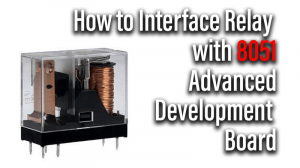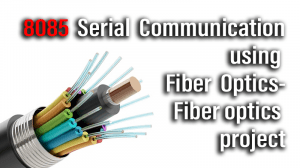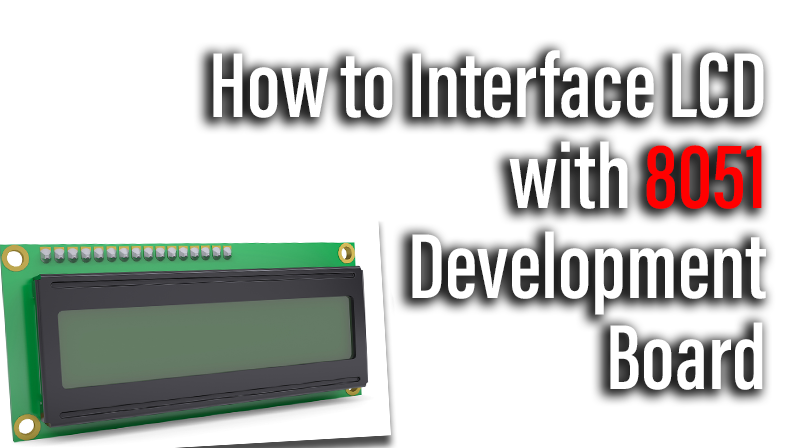
How to Interface LCD with 8051 Development Board
The 8051 Development board is specifically designed to help students to master the required skills in the area of embedded systems. The kit is designed in such way that all the possible features of the microcontroller will be easily used by the students. The kit supports in system programming (ISP) which is done through serial port.
NXP’s 8051 (AT89V51RD2), 8051 Development Kit is proposed to smooth the progress of developing and debugging of various designs encompassing of speed 8-bit Microcontrollers.
LCD (Liquid Crystal Display)
Liquid Crystal Display also called as LCD is very helpful in providing user interface as well as for debugging purpose. A liquid crystal display (LCD) is a flat panel display that uses the light modulating properties of liquid crystals (LCs). LCD Modules can present textual information to user.
Interfacing LCD
Fig. 1 shows how to interface the LCD to microcontroller. The 2×16 character LCD interface card with supports both modes 4-bit and 8-bit interface, and also facility to adjust contrast through trim pot. In 4-bit interface 7 lines needed to create 4-bit interface; 4 data bits (D0 – D3), three control lines, address bit (RS), read/write bit (R/W) and control signal (E).
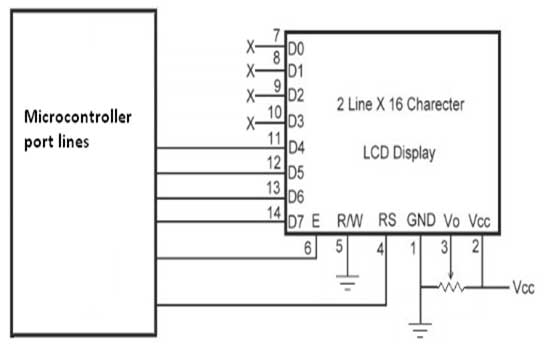
Interfacing 4 bit LCD with 8051
We now want to display a text in 8051 Development Board by using 4 bit LCD module.
The 8051 Development Board has seven numbers of LCD connections are needed to create 4-bit interface; connected with 4 data bits (P0.4 – P0.7, D4-D7), address bit (RS-P0.0), read/write bit (R/W-P0.1) and control signal (E-P0.2) to make LCD display.
Pin Assignment with 8051
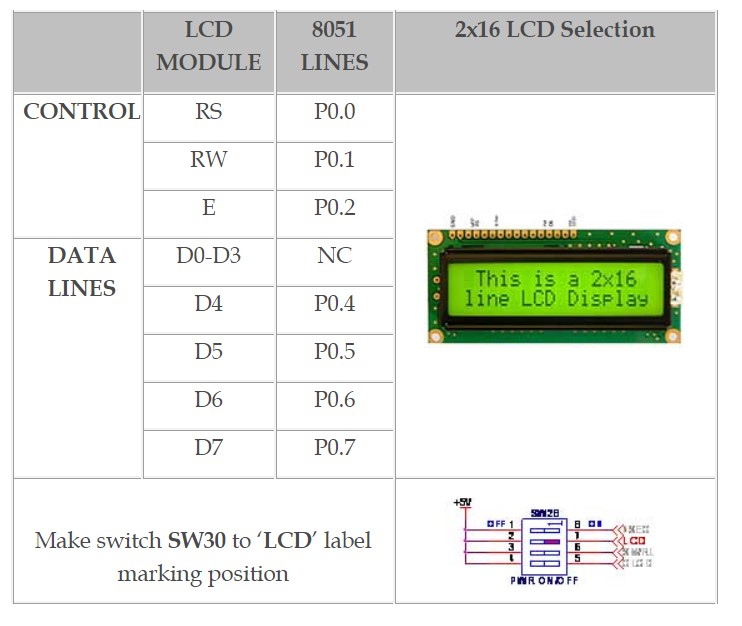
Circuit Diagram to Interface 4 bit LCD with 8051
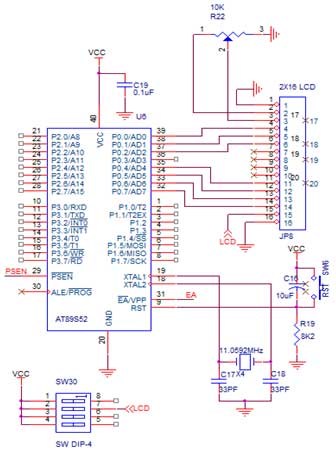
Source Code
The Interfacing 4 bit LCD with 8051 program is very simple and straight forward, which display a text in 2 X 16 LCD module using 4 data lines only. Some delay is occurring when a single command / data is executed.
C Program to display a text in 4 bit LCD using 8051
************************************************************************
Title : Program to 4 bit LCD display
************************************************************************
#include
//Define 8051 Registers
#include
//Define I/O Functions #define DATA P0
//Define DATA to Port2 sbit RS = P0^0;
//Register Select sbit RW = P0^1;
//LCD Read/Write sbit lcd_e = P0^2;
//LCD Enable code unsigned char msg[] = (" PS.PRIMER-8051 ");
//Display code unsigned char msg1[] = (" 2x16 LCD DEMO ");
//----------------------------------
//LCD Functions
//---------------------------------- void lcd_init(void); void lcd_cmd(unsigned char);
void lcd_display(unsigned char); void DelayMs(int);
//----------------------------------
// LCD command Function
//---------------------------------- void lcd_cmd(unsigned char cmnd)
{
DATA = 0xf0&cmnd;
//Masking lower 4 Bits RS = 0;
RW = 0; lcd_e = 1;
DelayMs(35); lcd_e = 0; DATA = cmnd*16;
//Masking lower 4 RS = 0;
RW = 0;
lcd_e = 1;
DelayMs(35);
lcd_e = 0;
}
//----------------------------------
// LCD Data Function
//----------------------------------
void lcd_display(unsigned char dat)
{
DATA = 0xf0&dat;
//Masking lower 4 RS = 1;
RW = 0;
lcd_e = 1;
DelayMs(35);
lcd_e = 0;
DATA = dat*16;
//Masking lower 4 RS = 1;
RW = 0;
lcd_e = 1;
DelayMs(35);
lcd_e = 0;
}
//----------------------------------
// LCD Delay Function
//----------------------------------
// LCD Initialization
//----------------------------------
void lcd_init(void)
{
unsigned char i;
lcd_cmd(0x28);
//2x16 Character 5x7 DelayMs(15);
//matrix LCD,4-bit format lcd_cmd(0x0c); DelayMs(15);
lcd_cmd(0x06);
//Shift DelayMs(15);
lcd_cmd(0x01); DelayMs(15);
//-------------------------------------------
// First Line Message Display
//-------------------------------------------
lcd_cmd(0x80);
DelayMs(35);
i=0;
while(msg[i]!='\0')
{
lcd_display(msg[i]);
i++;
}
DelayMs(50);
//-------------------------------------------
// Second Line Message Display
//-------------------------------------------
lcd_cmd(0xc0);
//Second DelayMs(35);
i=0;
while(msg1[i]!='\0')
{
lcd_display(msg1[i]);
i++;
}
DelayMs(50);
}
//----------------------------------
// LCD Main Program
//----------------------------------
void main(void)
{
P0 = 0;
lcd_init();
//LCD Initialization DelayMs(1);
DelayMs(1);
while(1);
//Loop Forever
}

